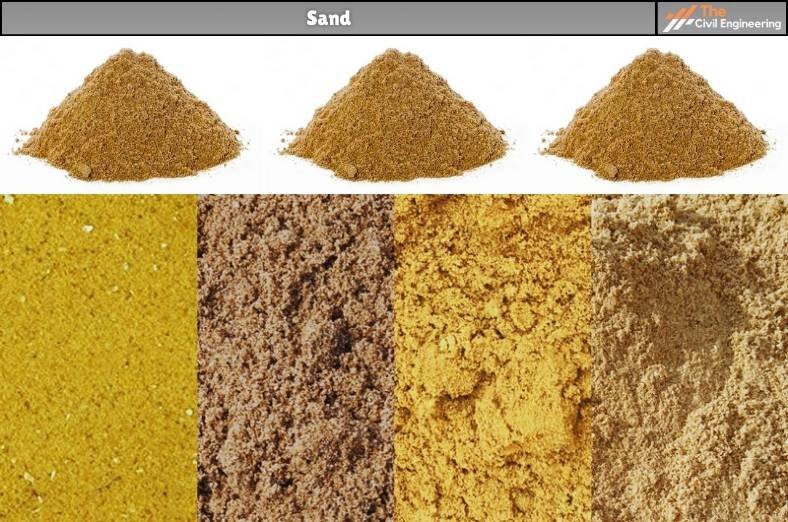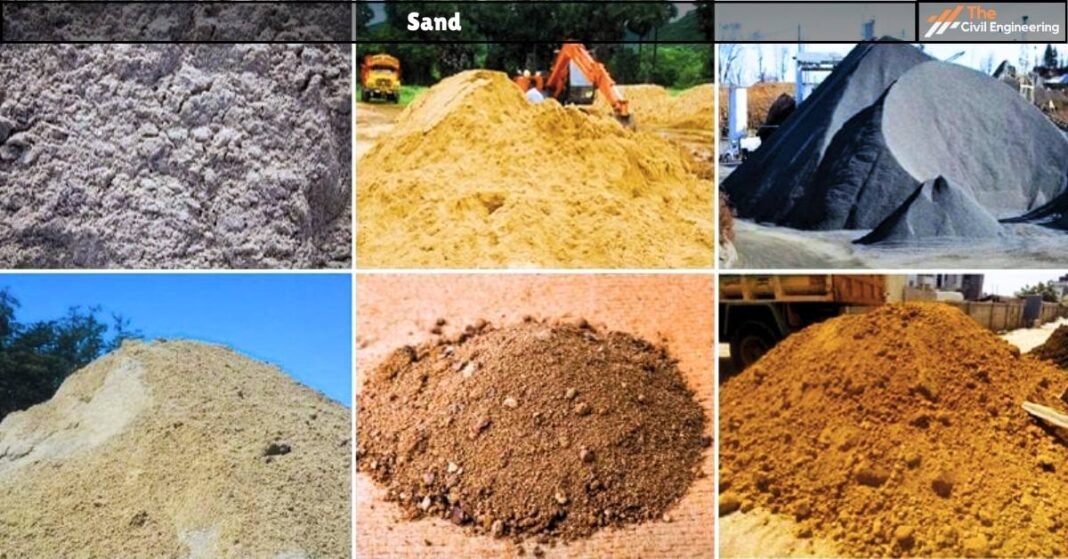1. Introduction
Sand can be defined as the mixture of small fine grains of granular materials and rock.
It is also commonly defined by size i.e. it is finer than gravel and coarser than silt ranging in size from 0.06mm to 2mm.
Most types of sand are formed by the erosion of soil, weathering of the rocks, broken pebbles and gravels carried by the rivers, streams etc.
The basic composition of sand mostly includes unconsolidated granular materials consisting of either rock fragments or mineral particles or oceanic materials.
It is mainly made of silicate minerals and silicate rock granular particles. The most dominant constituent is quartz because it consists of highly resistant properties to weather. The quartz is also commonly referred to as silicon dioxide.
Some other heavy minerals such as tourmaline, zircon etc and rock-forming materials such as micas and amphiboles can also be found in sand.
Sand is found in different colours such as white, black, white-grey, light brown etc.
It is regarded as a multi-purpose topographical material and is used extensively for various types of civil engineering works.
Sand is one of the chief constituents of concrete and thus is vital for concrete works. Types of sand are briefly explained below.

2. Types of Sand
There are 3 ways of sand classification. They are:
1. Based on the colour
2. Based on the size
3. Based on miscellaneous factors
a. Types of Sand Based on Color
According to the characteristic colour, there are 6 types of sand. They are:
a. White Sand:
As the name itself implies, it is white in colour.
This type of sand is mainly composed of eroded limestone as the chief component.
Apart from this, white sand may also contain magnetite, chlorite, glauconite, coral and shell fragments.
b. Black Sand:
It is black in colour.
It is essentially composed of volcanic materials, fragments of lava as well as coral deposits.
c. Pink Sand:
It is reddish-pink in colour.
Such reddish pink colour is imparted by a microscopic organism known as the foraminifera.
Pink sand also consists of corals, shells and calcium.
d. Red-Orange Sand:
The red-orange sand has a characteristic reddish-orange in colour.
This is due to the presence of iron oxide.
e. White-Grey Sand:
The white-grey sand consists of fine rounded grains and has a prominent whitish-grey colour.
This type of sand is usually well graded.
f. Light Brown Sand:
As the name itself implies, it is light-brown in colour.
It essentially consists of rounded grains.
b. Types of Sand Based on Size (ASTM Classification)
According to the size of the sand particles, there are 3 types of sand. They are:
a. Fine Sand:
The sand that passes through 16 number sieve is called fine sand.
It is most commonly used in plastering works.
| Sieve Designation | Nominal Sieve Opening | |
|---|---|---|
| Standard | Mesh | inches |
| 1.19 mm | No. 16 | 0.0469 |
| 1.00 mm | No. 18 | 0.0394 |
| 0.841 mm | No. 20 | 0.0331 |
b.Moderately Coarse Sand:
The sand that passes through 8 number sieve is called Moderately coarse sand.
It is used for mortar and masonry works.
| Sieve Designation | Nominal Sieve Opening | |
|---|---|---|
| Standard | Mesh | inches |
| 2.38 mm | No. 8 | 0.0937 |
| 2.00 mm | No. 10 | 0.0787 |
| 1.68 mm | No. 12 | 0.0661 |
c. Coarse Sand:
The sand that passes through 4 number sieve is called coarse sand.
It is commonly used for concrete works.
| Sieve Designation | Nominal Sieve Opening | |
|---|---|---|
| Standard | Mesh | inches |
| 4.76 mm | No. 4 | 0.187 |
| 4.00 mm | No. 5 | 0.157 |
| 3.36 mm | No. 6 | 0.132 |
c. Types of Sand Based on Miscellaneous Factors
There are 18 types of sand based on various miscellaneous factors. They are:
a. Coral Sand:
It consists of a mixture of particles that essentially originate from the tropical and the sub-tropical marine environments (i.e. the coral sands mostly originate from the bio-erosion of the limestone or skeletal material of the marine organisms).
Coral sand can simply be understood as the light-coloured sand mostly composed of calcareous fragments of biogenic origin. A significant example of such a biogenic process is the secretion of inorganic components such as silt and sand by the parrotfish during the digestion of consumed living tissues.
The coral sand is abundant in the Caribbean, around Hawaii, Polynesia, Indonesia, the Indian Ocean, the Australian North coast, the Red Sea, etc.
However, real and pure coral sands are found only in the vicinity of the coral reefs.
b. Glass Sand:
It consists of silicon dioxide as the chief constituent.
The glass sands are a vital source of silica for the glass and chemical industries.
This type of glass sand is also used for the water purification and filtration process, road works and concrete works.
c. Gypsum Sand:
It consists of the calcium sulphate dihydrate as the major component which is also called Gypsum (CaSO4. 2H2O).
Gypsum is a rare constituent in the sand as it is moderately soluble in water.
However, there exists a large dune field named White Sands National Monument in New Mexico that is entirely composed of tabular gypsum grains.
The existence of the gypsum sand in New Mexico is because this state does not have a very wet climate.
The region also does not have any outlet to the sea which means that gypsum grains that are dissolved in rainwater have no escape from the area and eventually may become sand grains again.
d. Ooid Sand:
Ooid sands mostly consist of rounded pellets and spheroidal coated sedimentary grains.
It also consists of calcium carbonate as the chief constituent.
The ooids are small rounded mineralized bodies.
The ooid grains commonly have a diameter less than 1mm.
e. Pit Sand:
Pit sand is the type of sand that is obtained from the pits present in the soil.
The pit sand grains are mostly sharp, angular and porous.
They do not contain a considerable amount of harmful substances.
The fine pit sand does not leave any stain when rubbed between the fingers.
It is used for mortars.
f. River Sand:
It is the sand that is obtained from the river beds and banks.
The river sand grains are fine, round and mostly polished due to the rubbing action of the water currents.
The river sand is characterized by a significant white colour. The river sand grains are comparatively smaller in size than the pit sand due to which it is more desirable for the plastering works.
Since the river sand is relatively pure; it is suitable for all kinds of civil engineering works and constructions.
One drawback of the river sand is that it has less frictional strength due to its roundness.
g. Seas Sand:
It is mostly obtained from the seashores.
As the river bed sand; the sea sand is also fine, rounded and polished due to the rubbing action of the water currents.
The sea sands have a characteristic light brown colour.
It is relatively less desirable in the civil engineering field as it contains an excessive amount of salts. Such salts absorb moisture from the atmosphere and result in permanent dampness and efflorescence when used in the structures.
This sand also contains a significant amount of organic matter which duly decompose in the body of the mortar and thus reduce their strength as well as the life span.
Due to all these reasons, as far as possible sea sand should not be used for the construction works.
h. Green Sand:
Green sand is the type of sand that consists of some greenish materials.
i. Desert Sand:
As the name itself implies, desert sand is the type of sand that is found in the deserts.
j. Lithic Sand:
It is mainly composed of small rocks and rock fragments.
k. Mixed Carbonate Silicate Sand:
It is composed of a mixture of organic as well as inorganic sand grains.
l. Biogenic Sand:
It is essentially composed of tiny skeletons, seashells, forams, corals etc.
m. Garnet Sand:
It consists of garnet as the major constituent. Garnet is a mineral.
n. Olivine Sand:
It is quite unstable. It is mostly employed for steel casting works.
o. Volcanic Sand:
It is mostly found in volcanically active or affected areas.
The volcanic sand is relatively darker in colour and has slightly different characteristics.
Sometimes, a significant amount of coal is also found in the volcanic sands.
p. Heavy Mineral Sand:
It consists of high mass molecules and is capable of forming a stable structure.
q. Continental Sand:
It is common all over the world and is used extensively for the construction of various structures.
r. Sand with Hematitic Pigment:
It contains hematitic pigment in its composition. Hematite mostly refers to the mineral that imparts a reddish pigment.
3. Extraction of Sand
Sand is mostly used construction material. It is usually extracted from the bank of the rivers by mining.
Nowadays, the main source for sand extraction is from rivers and marine.
Land quarries have been reduced a lit bit due to the decline of inland resources.
Marine sands need to be washed thoroughly in order to remove salt and other impurities. If the sand is not properly washed and still contains salt then there is a higher chance of failure of structure built because salt will corrode the metal structures.
Sand found in deserts is unsuitable for concrete and land reclaiming.
| Read More: Grades of Concrete |
| Read More: Properties of Bitumen |

